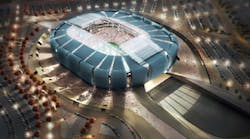The desert sun has beat down on the aluminum benches at Sun Devil Stadium in Tempe, Ariz., sizzling Arizona Cardinal football fans in their seats since 1988, when the NFL team moved from St. Louis to the Valley of the Sun.
Not anymore.
Rather than playing at Sun Devil Stadium, which was built in 1958 as a collegiate facility for the Arizona State University football team, the Cardinals will soon have a $370 million home on 25 acres of farmland in Glendale, Ariz. The Cardinals' new facility, which is designed to resemble a barrel cactus or a sunburst, will be the first NFL stadium with both a retractable roof and field. The roof can be closed during the summer months, when temperatures can climb to 115°, and opened during the winter to take advantage of Arizona's mild climate. The roof, which will be supported by four super columns, is being assembled on the ground in the center of the construction site. Once the stadium's concrete superstructure has been completed, the team will jack the roof up into place. Sterling Woods, general foreman for Phoenix-based Cannon & Wendt Electric, a 55-year old firm that renovated the Sun Devils' stadium in 1977 and 1978, says his team plans to prefab the conduit on the roof structure before it's lifted into position.
“We plan to do a lot of prefab work, so we are installing our conduit on the ground rather than having our electricians work 230 feet up in the air,” Woods says.
Cannon & Wendt Electric has an electrical contract in excess of $25 million to provide temporary and permanent power to the stadium, install lighting fixtures, and supply electricity to the four corners of the roof and both ends of the pull-out field. When the Cardinals are playing, the grass field will stay inside of the stadium, but when it's not being used, it will be pulled outside and parked in the sunlight. The natural grass field will be contained in a 12 million-pound, 244-foot wide by 234-foot long motorized steel tray set on rollers.
“The grass field rolls out on 11 rails like a giant pie pan or a standard railroad car,” says Ken Bowcock, project executive for Cannon & Wendt Electric. “They plug in both corners of the field, and a field crew will walk the field out with the cable.”
Underneath the grass field, the utility grid network will be embedded in the 152,000-square-foot concrete stadium floor so the facility can be used for not only professional football games, but also trade and consumer shows, conventions, concerts, motor sports, and rodeos. To provide power for the different events, the electricians will install 72 stainless steel floor boxes, which will run in rows between the rail footings.
“It gives you the multipurpose venue without having to worry about damaging the grass,” says Charlie Prewitt, construction manager for Hunt Construction Group, who has worked on two other NFL venues — Raymond James Stadium in Tampa, Fla., and Alltel Stadium in Jacksonville, Fla.
Because of the immense scope of the project, the crew is constructing the building as seven mid-rise towers. The workers often build an entire service level and then move on to the main concourse, but on this project, they're building each tower all the way from the service level to the upper concourse roof. Woods says it allows his electricians to keep working even as the concrete is being poured. The electrical contracting firm is also able to increase the efficiency and productivity on the jobsite through a design-build relationship, which allows the electricians to work with the engineers to rough-in the decks prior to the issuance of construction documents.
The Cardinals will move to the new air-conditioned stadium in 2006. While football fans may have to endure two more scorching seasons in Sun Devil Stadium, they'll soon be able to watch the oldest existing football club in the U.S. play on a natural grass field without sitting in the heat of the Arizona sun.
Electrical Needs by the Numbers
The electricians are installing a 2,000A, 3-phase temporary service, which will be replaced with six double-ended unit substations for permanent power.
To provide power to the retractable field, the electricians will install two 100A plug-in services at each corner of the field.
The retractable roof will require four 200A feeders.
640 1,500W metal halide fixtures will illuminate the stadium.
The job is expected to peak at 130 electricians.




